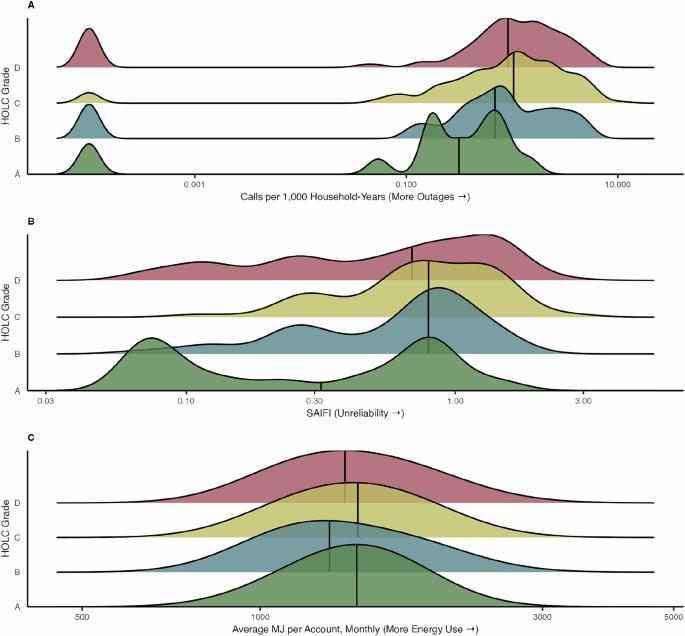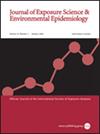Electricity inaccessibility across historically redlined and present-day disadvantaged areas in New York City
IF 4.7
3区 医学
Q2 ENVIRONMENTAL SCIENCES
Journal of Exposure Science and Environmental Epidemiology
Pub Date : 2025-04-22
DOI:10.1038/s41370-025-00767-1
引用次数: 0
Abstract
Electricity is crucial in sustaining livelihoods from turning the lights on at night, keeping the refrigerator running to avoid food spoilage, and powering electricity-dependent durable medical equipment such as nebulizers. Thus, electricity inaccessibility may result in adverse outcomes. Like other environmental burdens, electricity inaccessibility may be socially patterned, with disproportionate occurrence in racially and economically marginalized communities. To evaluate the 2017-2019 distribution of electricity inaccessibility – defined as power outages and energy insecurity – across historical and present-day measures of community racial disadvantage in New York City (NYC). We measured power outages with NYC 311 outage call reports and the System Average Interruption Frequency Index (SAIFI). We calculated energy insecurity as monthly average energy use, leveraging data from the New York State Energy Research and Development Authority. These three electricity inaccessibility metrics were estimated within both historical Home Owners’ Loan Corporation (HOLC) graded areas (A, ‘best’ through D, ‘redlined’) and present-day racial and economic Index of Concentrations at the Extremes (ICE) census tracts quartiles. Our study covered 396 HOLC areas and 2218 census tracts in NYC. Historically A-graded areas had fewer 311 outage calls and lower SAIFI. Additionally, the rate of 311 outage calls in the present-day most disadvantaged census tracts was nearly six times that of the most privileged tracts. Persistently disadvantaged areas (i.e., both poor HOLC grade and high ICE) had more power outages than consistently advantaged areas. However, the present-day most disadvantaged census tracts still had more power outages than persistently disadvantaged areas.

纽约市历史上的红线区和现在的弱势地区都没有电力供应。
背景:电力对于维持生计至关重要,从夜间开灯,保持冰箱运转以避免食物变质,到为雾化器等依赖电力的耐用医疗设备供电。因此,电力供应不足可能会导致不良后果。与其他环境负担一样,无法获得电力可能具有社会模式,在种族和经济边缘化社区的发生率过高。目的:评估2017-2019年纽约市电力不可及性(定义为停电和能源不安全)在历史和当今社区种族劣势指标中的分布。方法:我们用NYC 311停电呼叫报告和系统平均中断频率指数(SAIFI)来测量停电。我们利用纽约州能源研究与发展局的数据,以月平均能源使用量来计算能源不安全。这三个电力不可达性指标是在历史上的房主贷款公司(HOLC)分级区域(A,“最佳”至D,“红线”)和当今极端种族和经济集中度指数(ICE)人口普查区四分位数中估计的。结果:我们的研究覆盖了纽约市396个HOLC区域和2218个人口普查区。历史上a级地区的311停电呼叫较少,SAIFI较低。此外,在目前最不利的人口普查区,311个停电电话的比率几乎是最优越地区的六倍。长期处于不利地位的地区(即,较差的HOLC等级和较高的ICE)比长期处于有利地位的地区有更多的停电。然而,目前最不利的人口普查区仍然比长期处于不利地位的地区停电更多。影响:这项2017-2019年纽约市(NYC)研究评估了与社区特权和劣势相关的三个电力不可达性指标的分布。独特的是,我们评估了历史上红线地区和现在人口普查区的分布。我们将电力不可及性定义为停电(311电话和电力中断)和能源不安全(住宅能源使用)。我们发现,311电话和电力中断在历史上的红线地区、现在的弱势人口普查区和持续的弱势地区更为常见。这些发现表明,历史上的种族歧视(如红线)和现代社区的不利因素影响了纽约获得可靠电力的机会。
本文章由计算机程序翻译,如有差异,请以英文原文为准。
求助全文
约1分钟内获得全文
求助全文
来源期刊
CiteScore
8.90
自引率
6.70%
发文量
93
审稿时长
3 months
期刊介绍:
Journal of Exposure Science and Environmental Epidemiology (JESEE) aims to be the premier and authoritative source of information on advances in exposure science for professionals in a wide range of environmental and public health disciplines.
JESEE publishes original peer-reviewed research presenting significant advances in exposure science and exposure analysis, including development and application of the latest technologies for measuring exposures, and innovative computational approaches for translating novel data streams to characterize and predict exposures. The types of papers published in the research section of JESEE are original research articles, translation studies, and correspondence. Reported results should further understanding of the relationship between environmental exposure and human health, describe evaluated novel exposure science tools, or demonstrate potential of exposure science to enable decisions and actions that promote and protect human health.

 求助内容:
求助内容: 应助结果提醒方式:
应助结果提醒方式:


